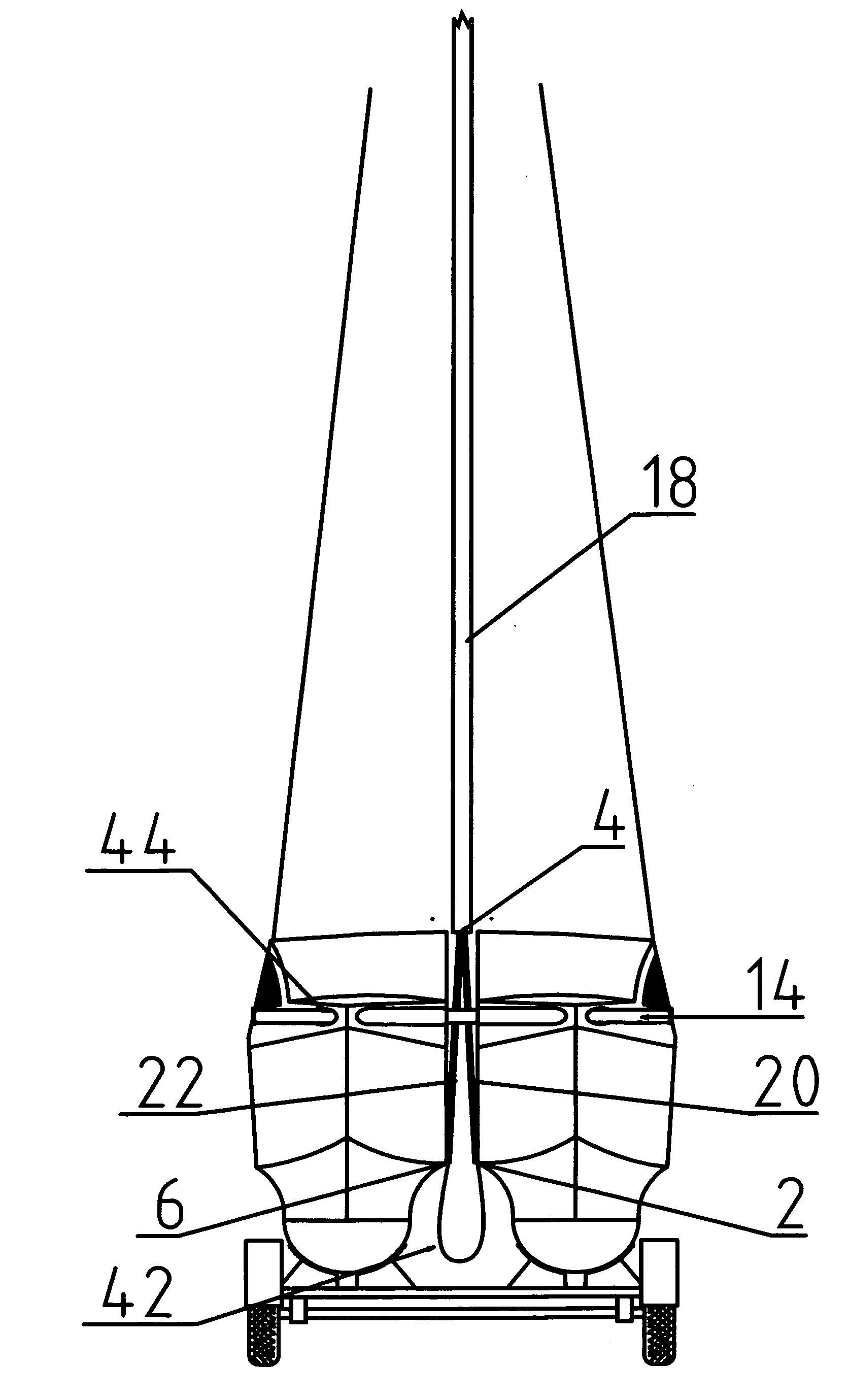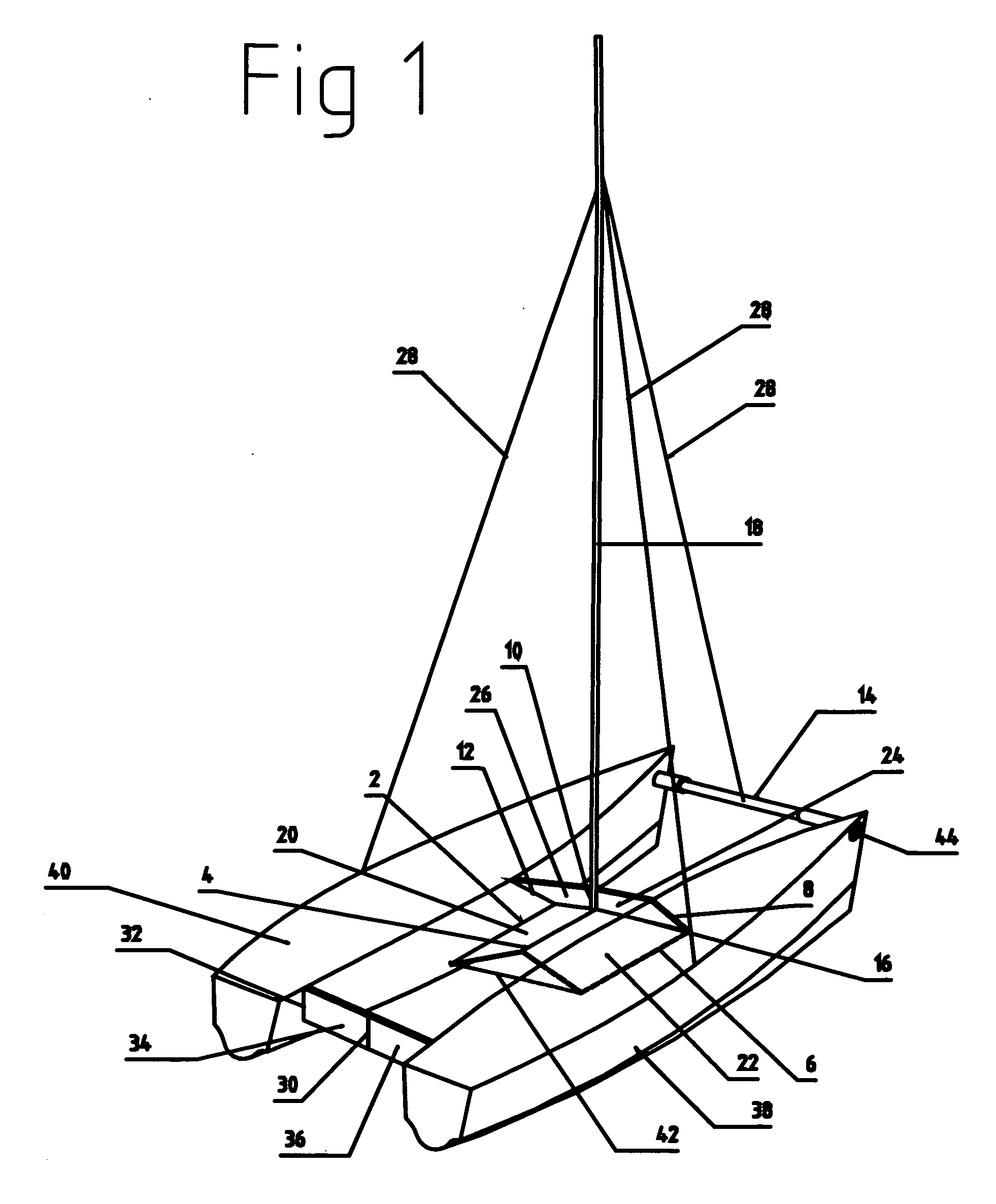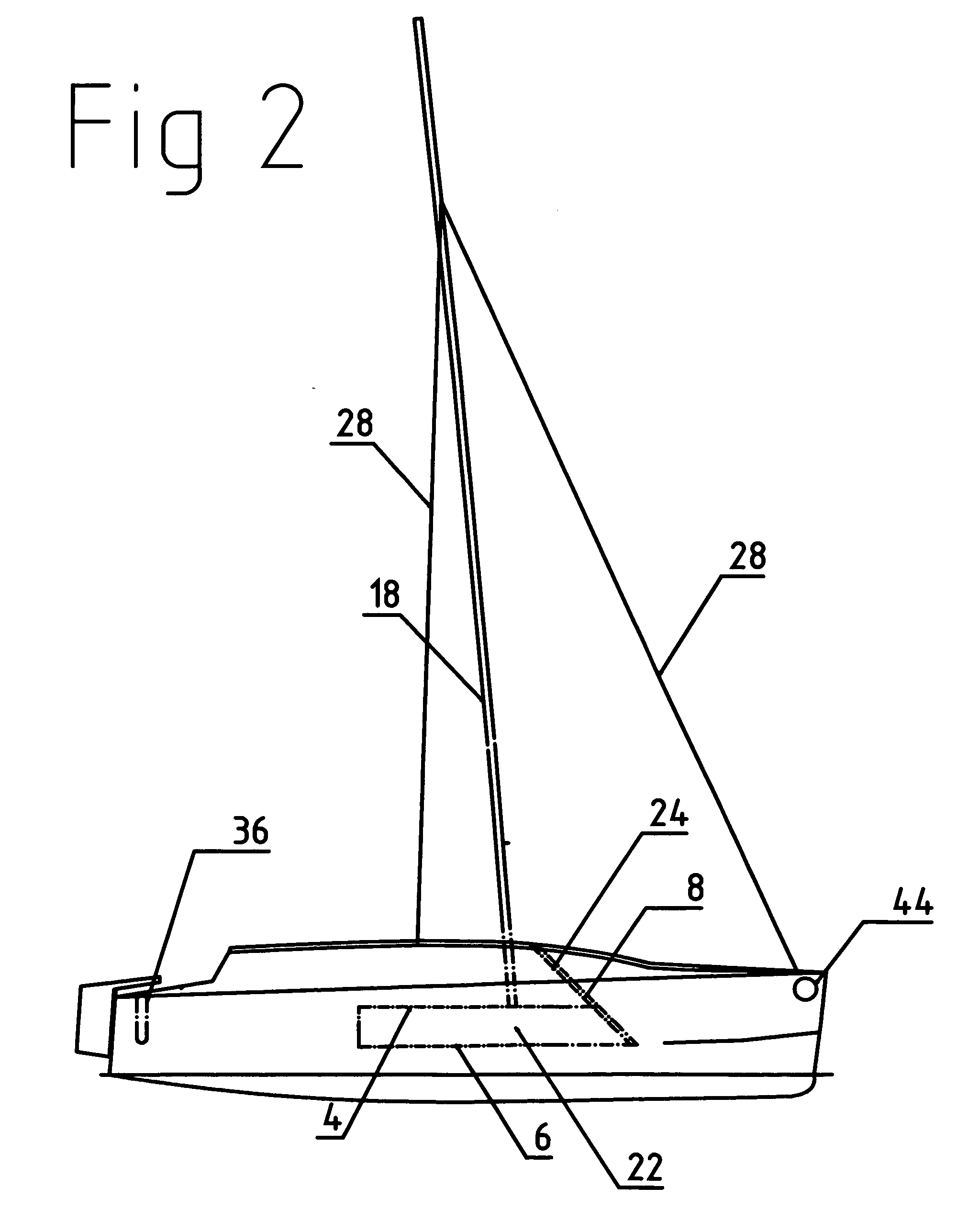In many localities the extra area taken up by the greater width of a catamaran produces problems in their storage.
Many marinas charge extra fees to berth a catamaran and some marinas are unable to accept catamarans due to the position of
mooring poles and such.
When catamarans need to be taken out of the water many slipways and travel lifts are unable to accept them due to the catamaran's great width.
Catamarans are usually light and easily moved but their great width makes them difficult to remove from the water on normal equipment.
The problem until now has been how to reduce the catamaran's beam when required.
None of these has resulted in the trailerable catamaran becoming common due to a deficiency in the usefulness of each separate concept.
The problems with this approach are that the mast cannot be in the raised position when undergoing extension or retraction and that large sleeves in the interior of the hulls compromise the amenity of the
hull's interior.
This is very hard to achieve in practice as
dirt and scratches increase the friction of the sliding parts.
On top of this a small gap must be left between each telescopic section which increases the slack in the beam.
In practice it has been found to be very hard to reduce beam with this arrangement and most catamarans of this type are rarely retracted once launched.
Builders using this design have reported much hardship in getting the sliding beams to slide during expansion and retraction.
One of the great problems that the designer has been unable to rectify is how to produce a well engineered and easy to make sliding
beam system.
The many efforts of builders have gone into solving this problem but even with many minds working on the problem these boats have not been seen expanding and retracting as theory says they should.
One problem with the theory is scaling up the loads that occur in models.
Although the telescopic approach can be made to work on small boats the physical fact that loads increase much faster than size, (the so called square / cube rule in which things get weaker as they get bigger, witness a small boat being able to easily lie on a
rough surface whereas a vast ship would break its back) means that many theories that work well in small sizes do not work when applied to catamarans over model size.
Development was needed to overcome this in the prototype and the beams used in the prototype also had to move easily under heavy loads.
Telescopic beams are not especially strong as they rely on each part being “buried” in its neighbour to pass along the forces they are designed to
resist.
If the amount of bury is increased the beam of the catamaran must be reduced which is undesirable, or the number of telescopic elements has to be increased which increases the complexity, weight and slack in the beam.
This approach can produce a more structurally sound catamaran than the telescopic beam catamaran but has many problems.
One of the main problems with this approach is that reducing the beam of the catamaran is a long and laborious process and cannot be done in a reasonable timeframe.
On top of this bolt together assemblies are not highly suitable for the cyclic loads found in catamaran structures.
Its major drawback is that it requires a special trailer and cannot be folded in the water.
Additionally the hulls are not useful as storage or
accommodation on the trailer as the hulls are rotated through 90 degrees when folded.
However like Kelsall's catamarans the limitations placed on use, a special trailer is needed for folding and deep launching ramps needed for trailering, means that these boats are rarely built.
However his method is only suitable for trimarans and not for catamarans as catamarans have very different structural requirements and loading conditions.
Trimarans do not have the same advantages as catamarans in terms of
accommodation and interior and exterior utility.
Trimarans are rarely built as cruising boats these days due to these limitations.
However the rotating panels proved unable to properly cope with the loads found on a catamaran out on the water and these boats were rarely used and often found with their beams bolted permanently to guard against
structural failure.
The vertically hinged panels were easy to build and could rotate easily without load but under loading they showed many signs of strain.
While this is a reasonable technique in some ways it does not cater for the extreme loads found in a catamaran's beam.
One difficult problem is that of keeping the two panels that make up the mast beam straight.
The top of the beam however is under extreme compression forces, when mast loading is applied, and putting a hinge in a beam and then trying to keep it straight under compression is very difficult.
Putting hinges in the middle of a simply supported beam reduces the ability of that beam to
handle load.
Putting hinges in this area will not produce a robust structure.
Many of the twisting and torque loads found when in rough water put huge forces on any crossbeam arrangement.
This loads the beam and mast more highly and is not a reliable method for beginner and social boat users.
The use of vertically rotating panels is useful for some areas of a catamarans structure but what Pelly and others including Francke (see below) do not recognise are the huge forces that try to rotate the hulls of a catamaran so that both hulls want to rotate their decks inwards as the boat is retracted.
The loads on the folding mechanism are huge at point when the hinge and panel
system becomes weaker due to their being in an angled orientation rather than in a straight orientation as when sailing.
Francke's patent uses very high quality and expensive components to cater for the highly stressed simply supported beams and connective structures.
Francke's patent has problems that are shown in the changes to his prototype after its initial testing.
Much credit must go to Francke for developing his prototype to full size but at full size complications due to unrecognized loads can prove detrimental.
Obviously there are problems with a vertically rotating mast
support system as the mast loading puts greater and greater side loads on the hinges in the structure as the catamaran folds.
The main problem with a horizontally pivoting mast panel arrangement is providing strength to
resist the huge mast compression forces when each panel arrangement needs three hinge points to be able to fold up during the
hull's retraction.
If the panels are to be used as simply supported beams like those of Pelly and Francke then thin panels would not be able to be used and a major structure would be needed to brace the centreline hinge from rotating under the mast loading.
Obviously thin horizontally rotating panels cannot be used in the typical catamaran method of the simply supported beam.
These catamarans are usually racing orientated boats and do not have a folding capability.
This arrangement has many pitfalls.
It is very wasteful of
deck space, makes
crew movement more difficult and is not at all suitable for folding.
When looked at as a whole a major problem with the folding catamaran patents listed above is that they fail to cope adequately with the huge cyclic loadings catamarans can generate whilst being easy and inexpensive to manufacture and promote successful folding and extension.
Catamaran beams can rapidly change their loading conditions and in heavy seas the structure can have very
high load reversals in a very short period of time.
The structure used in “Excess” and “Wired” is structurally sound and also uses only compression and tension members but is in no way foldable.
However the tendency of all catamarans to rotate each
hull so that the
deck rotates inwards, the displacement of each hull vertically and the tendency of a catamaran to rotate one hull relative to the other when lifting a hull is not resisted well.
 Login to View More
Login to View More  Login to View More
Login to View More 


